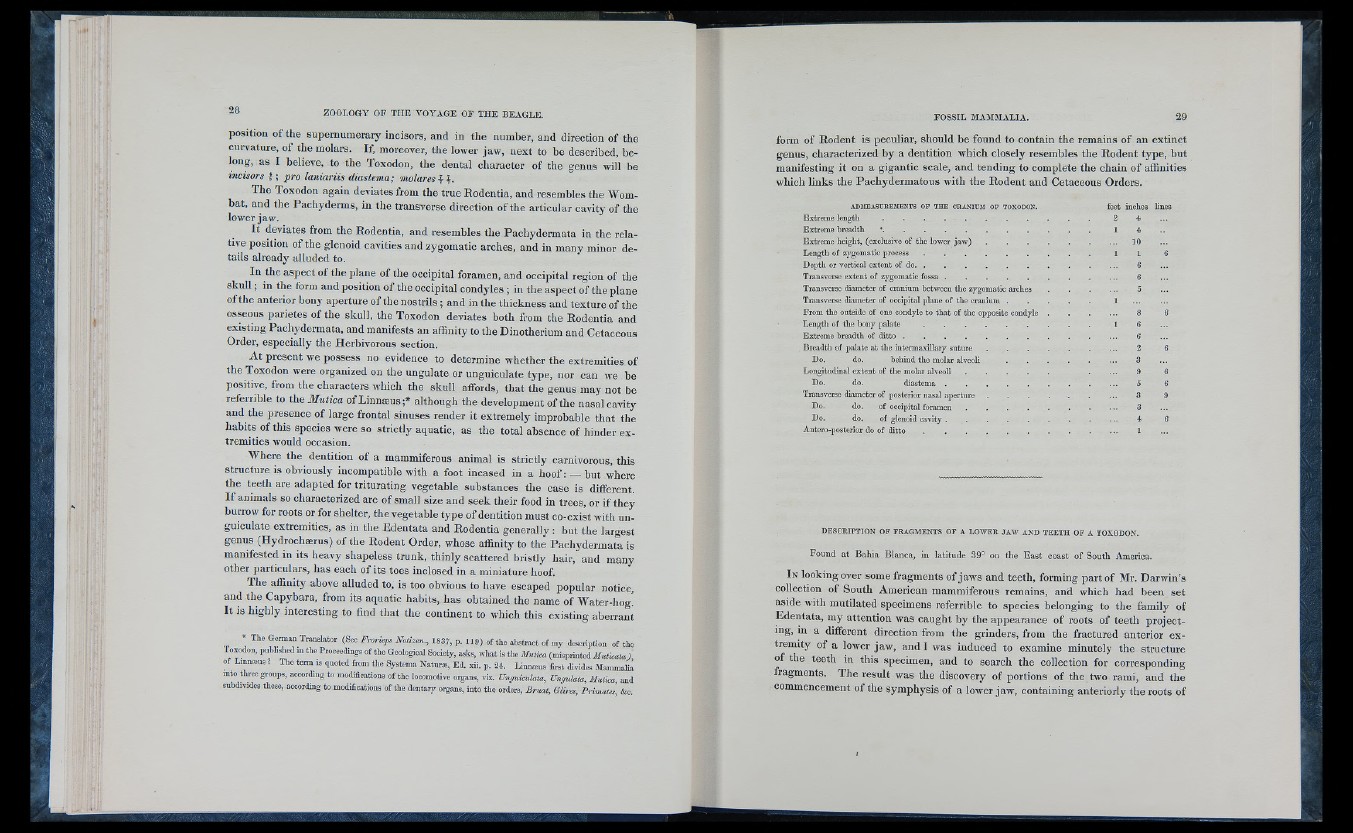
position o f the supernumerary incisors, and in the number, and direction o f the
curvature, o f the molars. If, moreover, the lower jaw, next to be described, belong,
as I believe, to the Toxodon, the dental character o f the genus will be
incisors i', p ro laniariis diastema; molares
The Toxodon again deviates from the true Rodentia, and resembles the Wombat,
and the Pachyderms, in the transverse direction o f the articular cavity o f the
lower jaw.
It deviates from the Rodentia, and resembles the Pachydermata in the relative
position o f the glenoid cavities and zygomatic arches, and in many minor details
already alluded to.
In the a spe ct o f the plane o f the occipital foramen, and occipital region of the
skull ; in the form and position o f the occipital condyles ; in the a spe ct o f the plane
o f the anterior bony aperture o f the nostrils ; and in the thickness and texture o f the
osseous p añe tes o f the skull, the Toxodon deviates both from the Rodentia and
ex isting Pachydermata, and manifests an affinity to the Dinothérium and Cetaceous
Order, especia lly the Herbivorous section.
A t present we p o ssess no evidence to determine whether the extremities o f
the Toxodon were organized on the ungulate or unguiculate type, nor can we be
positive, from the characters which the skull affords, that the genus may not be
referrible to th e Mutica o fLinnæus;* although the development o f the nasal cavity
and the presence o f large frontal sinuses render it extremely improbable that the
habits o f this spe cie s were so strictly aquatic, as the total absence o f hinder e x tremities
would occasion.
Where the dentition o f a mammiferous animal is strictly carnivorous, this
structure is obviously incompatible with a foot incased in a h o o f: — but where
the teeth are adapted for triturating vegetable substances tlie case is different.
I f animals so characterized are o f small size and se ek their food in trees, or i f they
burrow for roots or for shelter, the vegetable type o f dentition must co -ex ist with un-
guiculate extremities, as in the Edentata and Rodentia generally : hut the largest
genus (Hydrochærus) o f the Rodent Order, whose affinity to the Pachydermata is
manifested in its heavy shapeless trunk, thinly scattered bristly hair, and many
other particulars, has each o f its toes inclosed in a miniature hoof.
Th e affinity above alluded to, is too obvious to have escaped popular notice,
and the Capybara, from its aquatic habits, has obtained the name o f Water-hog’
It is h igh ly interesting to find that the continent to which this ex isting aberrant
* The Gemen Translator (See Froriept, N otizm., 1837, p. 119) o tth e abstract of my description ot the
Toxodon, pnhlishod In the Proceedings ot the Geological Society, asks, what is the Mutica (misprinted M m im a )
of Lmnams? Tiie term is , noted from the Systems Natnrrn, Ed. xii. p. 24. Linnams first divides Msmm.lte
into three groups, according to modifications of the locomotive organs, viz. Ungnieulata, Ungnlata, Mutica, and
subdivides these, according to modifications of the dentary organs, into the orders, B rm t , Glirez, Primate,, &c
form o f Rodent is peculiar, should be found to contain the remains o f an extinct
genus, characterized by a dentition which c lose ly resembles the Rodent type, but
manifesting it on a gigantic sca le , and tending to complete the chain o f affinities
which links the Pachydermatous with the Rodent and Cetaceous Orders.
ADMEASDEEMENTS OF TUE CEANIÜM OP TOXODON.
Extreme l e n g t h ........................................................................
Extreme breadth . . . . . . . . .
Extreme height, (exclusive of the lower jaw)
Length of zygomatic process . . . . . .
Depth or vortical extent of do........................................................
Transverse extent of zygomatic f o s s a .........................................
Transverse diameter of cranium between the zygomatic arches
Transverse diameter of occipital plane of the cranium .
From the outside of one condyle to that of the opposite condyle
Length of the bony palate . . . . . .
Extreme breadth of d i t t o ..............................................................
Breadth of palate a t the intermaxillary suture
Do. do. behind the molar alveoli
Longitudinal extent of the molar alveoli . . . .
Do. do. d i a s t em a .........................................
Transverse diameter of posterior nasal aperture
Do. do. of occipital foramen . . . .
Do. do. of glenoid c a v ity ...........................................
Antero-posterior do of d i t t o ....................................................
feet inches lines
2 4
DESCRIPTION OF FRAGMENTS OF A LOWER JAW AND TEETH OF A TOXODON.
Found at Bahia Blanca, in latitude 39° on the East coast of South America.
I n looking over some fragments o f jaw s and teeth, forming part o f Mr. Darwin’s
collection o f South American mammiferous remains, and which had been se t
aside with mutilated specimens referrible to spe c ie s belonging to the family o f
Edentata, my attention was caught b y the appearance o f roots o f teeth projecting,
in a different direction from the grinders, from the fractured anterior e x tremity
o f a lower jaw, and I was induced to examine minutely the structure
o f the teeth in this specimen, and to search the collection for corresponding
fragments. T h e result was the discovery o f portions o f the two rami, and the
commencement oi the sym ph y sis o f a lower jaw, containing anteriorly the roots o f